Georgia is a large southern state in the United States of America. The state covers 59,425 square miles. Here, you can find thick forests, beautiful waterfalls and lakes, and stunning mountain ranges. It’s not surprising that such a vibrant state is also home to over 4,000 native species of plants. Some of these plants though are dangerous. Most dangerous poisonous plants in Georgia aren’t deadly, but they can cause uncomfortable reactions. If too much of a toxic plant is ingested though, it can lead to death.
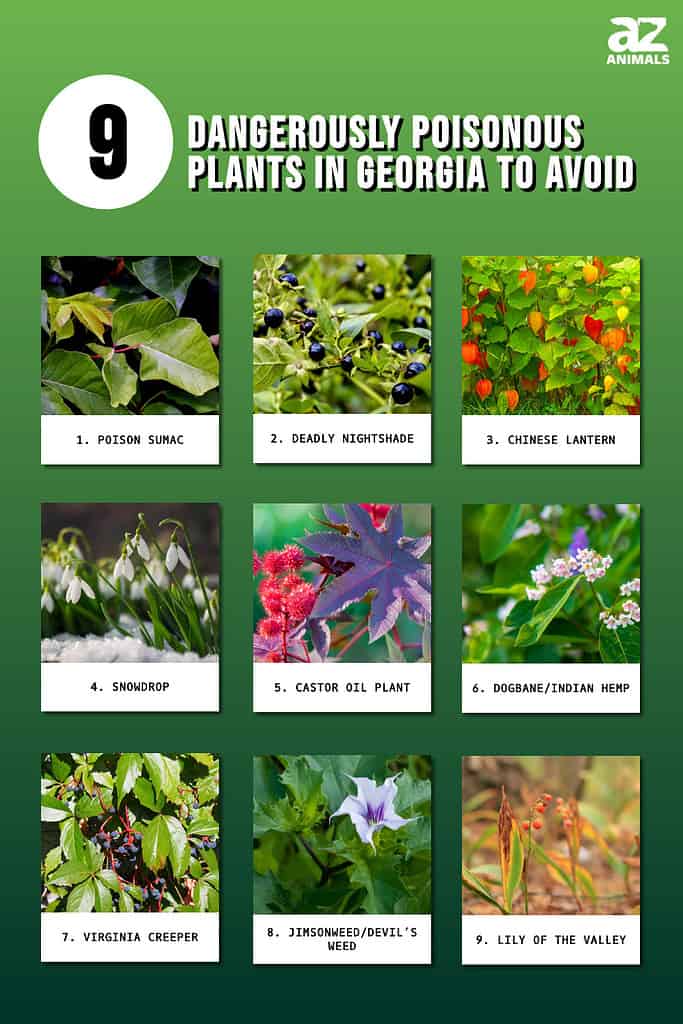
Not all common poisonous plant species in Georgia are native, but they thrive and grow throughout the state. It’s important to know what each plant looks like and the effects they cause. Follow along to learn more about nine dangerous poisonous plants in Georgia that you should avoid.
1. Poison Sumac (Toxicodendron vernix)
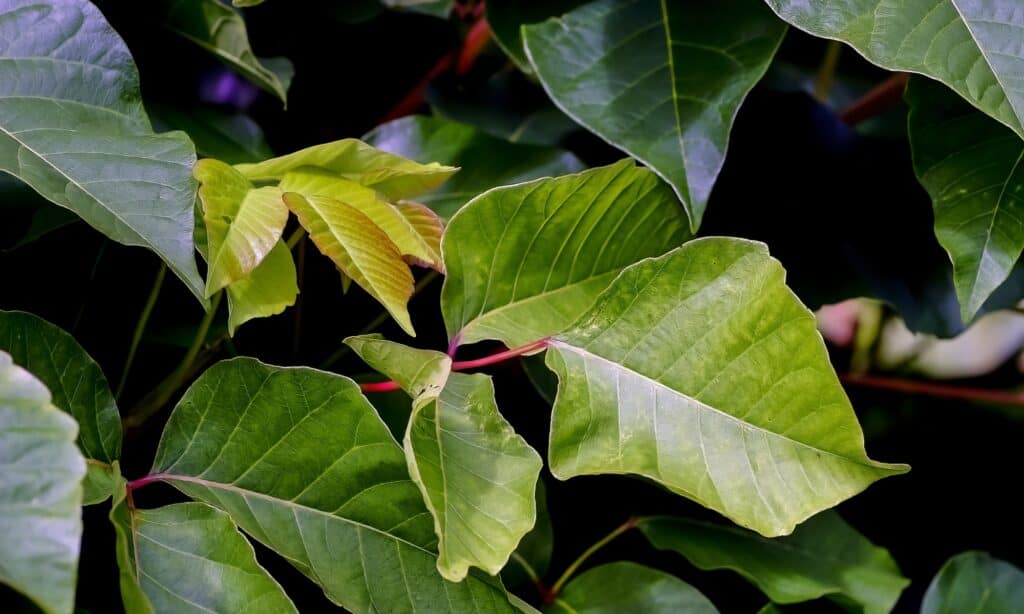
The poison sumac is one of the poisonous plants in Georgia that can cause rashes and respiratory problems.
©iStock.com/Werner Meidinger
The first on our list of poisonous plants in Georgia is the poison sumac. It’s native to the southern United States, but you can find it as high up as southeast Canada. It’s very common in Georgia and has bright green leaves with red stems. Sometimes the leaves have a red or brown tint to them. This plant is a small tree or shrub, reaching up to 30 feet tall. It also produces greenish flowers. Poison sumac fruit is about 4 to 5 millimeters long.
Interestingly, poison sumac plants aren’t toxic to birds or other mammals. They are eaten by wildlife when other food is scarce. Still, when consumed by humans, cause urushiol-induced contact dermatitis. While poison sumac is related to poison ivy and poison oak, it’s more toxic. Although touching poison sumac leads to uncomfortable red rashes, it’s worse to burn and inhale this plant since it can cause severe allergic respiratory problems.
2. Deadly Nightshade (Atropa belladonna)
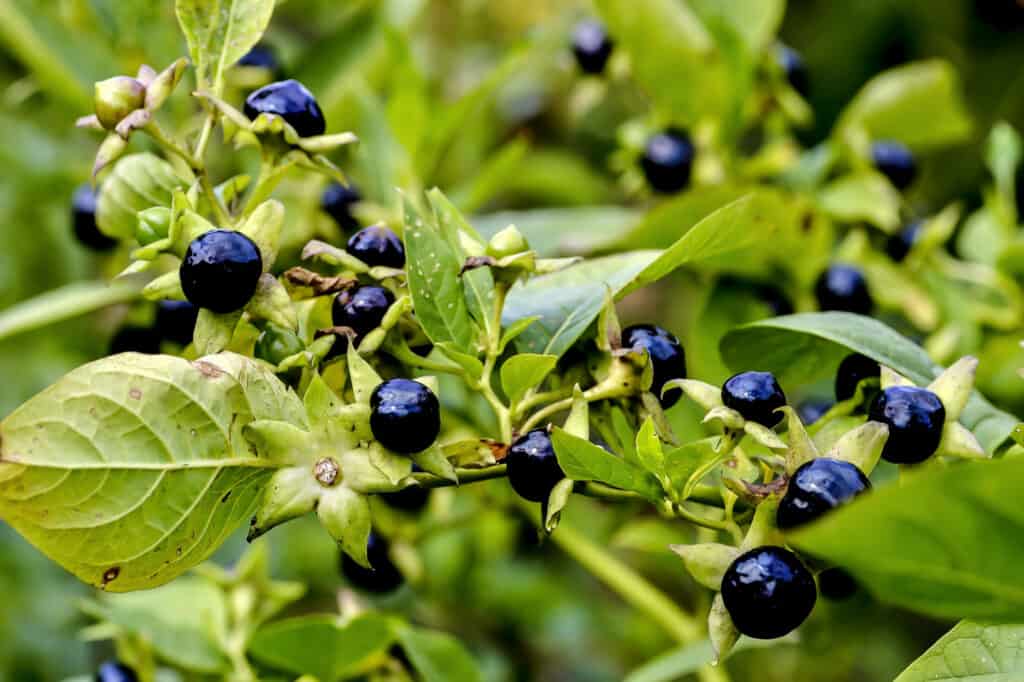
All parts of the belladonna plant are deadly, including its berries.
©Simon Groewe/Shutterstock.com
Although deadly nightshade is not native to North America, it is common in Georgia. Instead, this plant is native to Europe, North Africa, and Western Asia. Deadly nightshade is also commonly known as belladonna and is part of the nightshade family Solanaceae. It is a very toxic plant and should not be consumed. Both the leaves and the berries contain high amounts of tropane alkaloids. When ingested, this plant can lead to delirium and hallucinations. Although the plant wasn’t named Atropa belladonna until the 1700s, it’s been used throughout history for cosmetics, medicine, and as a deadly poison. For example, it’s believed that the Roman empress, Livia Drusilla, used the juice of deadly nightshade berries to kill Emperor Augustus, her husband. Even early humans used deadly nightshade as a poison and created poisonous arrows from the plant.
3. Chinese Lantern (Physalis alkekengi)

Chinese lantern plants are poisonous, causing stomach pain, difficulty breathing, and more.
©Obraz/Shutterstock.com
Another common poisonous plant in Georgia is the Chinese lantern. It is one of the top poisonous plants in Georgia. It’s a poisonous plant with bright orange seed pods. These beautiful, but toxic plants can cause stomach pain, shortness of breath, numbness, and dilated pupils when consumed. Not only are the seeds and leaves toxic, but so are the unripe berries. Chinese lanterns are also known as strawberry ground cherries and they aren’t native to the U.S. In Georgia, you can find them in dry and disturbed wooded areas. Some people grow Chinese lanterns as ornamentals, but the fruit is safe to eat when ripe.
4. Snowdrop (Galanthus)

Snowdrop flowers are beautiful, but also poisonous containing active lectin or agglutinin, and phenanthridine alkaloids, which is poisonous to pets.
©iStock.com/Muzka
The snowdrop flowers are beautiful. They emerge in spring and are one of the earliest blooming spring bulbs. There are about 20 species of snowdrop flowers with their own unique characteristics and traits. Snowdrop flowers are native to Europe and the Middle East, but they were introduced to the United States and grow well in Georgia. They also have a long and rich history and were first described in the fourth century BCE by the classical Greek author, Theophrastus. They are best known for their white drooping flowers and love green leaves. As beautiful as these flowers are, they are also toxic containing an active lectin or agglutinin. Snowdrop bulbs are especially dangerous for pets since the bulbs contain the highest concentration of phenanthridine alkaloids.
5. Castor Oil Plant (Ricinus communis)
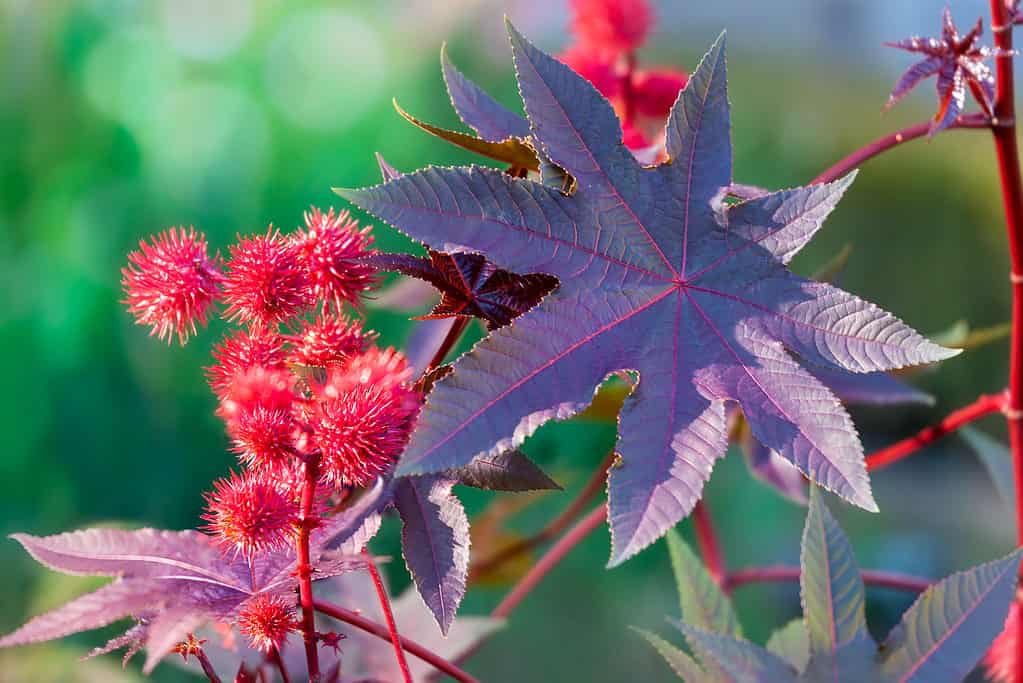
Castor oil plants can cause death if too many seeds are consumed.
©iStock.com/TatianaMironenko
This plant may look beautiful, but it is one of the most poisonous plants in Georgia. The castor oil plant, also known as the castor bean, is a perennial flowering plant mainly native to the southeastern Mediterranean Basin, Eastern Africa, and India. While they aren’t native to Georgia, they grow well in warm areas. Castor oil plants grow well in most tropical regions. They aren’t cold-hardy and are grown in the United States as decorative plants.
These beautiful plants have long and thick glossy green leaves and reach up to 39 feet tall. Castor seeds have many uses, but they are also toxic if not prepared correctly. Not only is the plant toxic, but it’s also an allergen. Castor oil plants produce a large amount of lightweight pollen which travels quickly, triggering allergies. Raw castor beans are dangerous because they contain ricin. While death from castor seed poisoning is rare, a lethal amount for adults is 4 to 8 seeds.
6. Dogbane/Indian Hemp (Apocynum cannabinum)

The dogbane plant is poisonous to humans, animals, and some insects.
©Ashley Swanson/Shutterstock.com
Hemp dogbane is a common poisonous weed in the United States. It’s native to most of North America like Georgia and can be found in the southern half of Canada. Hemp dogbane spreads quickly and is a nuisance in gardens. It’s not just poisonous to humans, but also to dogs, horses, and cats. All parts of the plant are toxic and contain cardiac glycosides. Hemp dogbane contains a sticky white sap that causes skin blisters. Interestingly, while this plant is toxic to most animals and some insects, it’s an important larval host for the snowberry clearwing. The dogbane tiger moth and the zebra caterpillar also rely on this toxic plant.
7. Virginia Creeper (Parthenocissus quinquefolia)
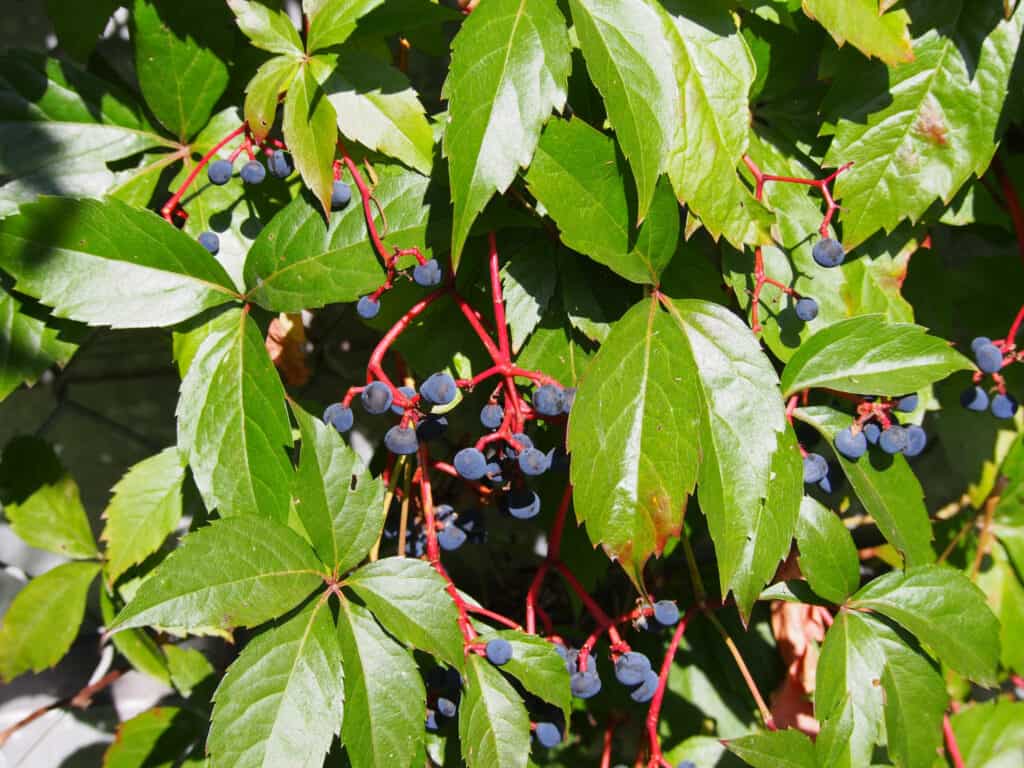
A popular vining plant, Virginia creeper berries are toxic.
©Anna Gratys/Shutterstock.com
Virginia creeper vines are five-leaved flowering ivy plants native to eastern and central North America. You can find this plant as south as eastern Mexico and Guatemala. Virginia creepers are often confused for poison ivy. They spread quickly and easily climb surfaces. You can find Virginia creepers in Georgia on the sides of many buildings trailing up. During fall, the leaves turn red. The flowers are small and green and grow in large clusters. During summer and fall, the flowers produce small, purplish-black berries less than half an inch long. The tiny berries are dangerous to humans and should not be consumed, however, they are important for many bird species.
8. Jimsonweed/Devil’s Weed (Datura stramonium)
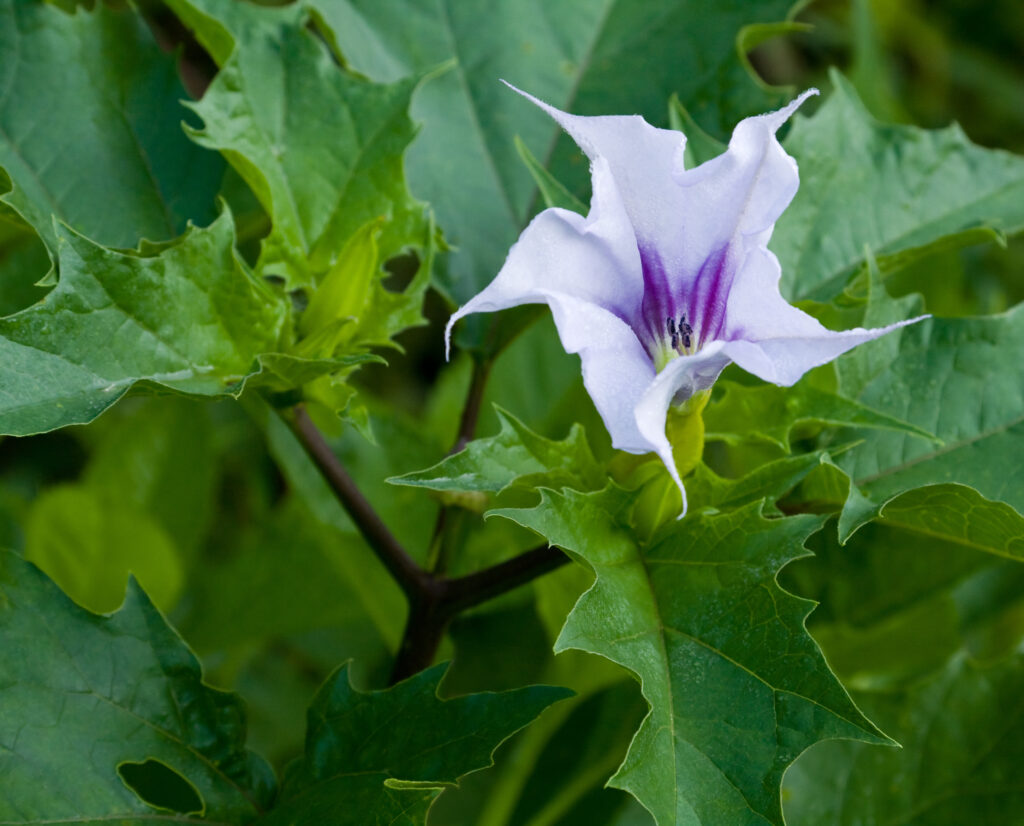
Although death is uncommon, devil’s weed intoxication produces bizarre behaviors, insomnia, nausea, hallucinations, urinary retention, and amnesia.
©Melinda Fawver/Shutterstock.com
Devil’s weed is one of the top poisonous plants in Georgia. It is a flowering plant native to North America. However, it was introduced to other parts of the world and it has now been naturalized. It’s an invasive and poisonous weed harmful to most animals, including humans. Devil’s weed is an annual herb that spreads quickly. It can easily form a bush up to five feet tall. They are best known for their beautiful and fragrant white-to-creamy or violet trumpet-shaped flowers. Although death is rare when consuming devil’s weed, it still contains high amounts of the tropane alkaloids atropine, hyoscyamine, and scopolamine. They are deliriants that can produce psychoactive effects.
9. Lily of the Valley (Convallaria majalis)

While the lily of the valley plant looks beautiful in bloom, it produces poisonous berries.
©Klymenko Mariia/Shutterstock.com
Last but not least is the lily of the valley. This poisonous woodland flowering plant has small white and fragrant bell-shaped flowers. It is native to the cool temperate Northern Hemisphere in Asia and Europe. However, one variety, the American lily of the valley, is native to North America. You can find the North American variety in the Southern Appalachians. They thrive in mountainous areas and rocky or sandy dry woodlands of Georgia. Lily of the Valley plants should never be ingested since they contain high amounts of cardiac glycosides. Ingesting this plant can cause irregular heartbeats, sweating, nausea, vomiting, and abdominal pain. The plant also produces bright red berries. It’s more common for children to fall ill from consuming lily of the valley berries. It’s especially dangerous if they eat more than five berries in one sitting. However, the flowers and leaves are also toxic, not just the berries.
Summary of 9 Dangerously Poisonous Plants in Georgia to Avoid
| # | Poisonous Plant | Reaction |
|---|---|---|
| 1 | Poison Sumac | Causes uncomfortable rashes |
| 2 | Deadly Nightshade | Extremely poisonous when ingested, can cause death |
| 3 | Chinese Lantern | Cause stomach pain, shortness of breath, numbness, and dilated pupils |
| 4 | Snowdrop | Extremely toxic to pets |
| 5 | Castor Oil Plant | Toxic and allergic |
| 6 | Dogbane/Indian Hemp | Causes skin blisters |
| 7 | Virginia Creeper | Berries are dangerous for humans |
| 8 | Jimsonweed/Devil’s Weed | Deliriants that can produce psychoactive effects |
| 9 | Lily of the Valley | Causes irregular heartbeats, sweating, nausea, vomiting, and abdominal pain |
| 10 |
How to Remove Poisonous Plants From Your Yard

Herbicides can be used to treat a large area of poisonous plants or trees.
©Worledit/ via Getty Images
After reading this article you may have noticed a familiar-looking plant and learned that it is poisonous. What is the best way to remove dangerous plants from your yard? It depends on how much area the plant is occupying and if it is in close proximity to plants that you want to preserve. Spraying herbicides can certainly eliminate the offensive plant but may harm others.
If you have a large area of poison ivy or another low-lying poisonous plant – it is possible to kill it by positioning a tarp over it to smother it. Taller plants may be best removed by weeding or digging them up. Be sure to wear protective clothing, gloves, and a mask to prevent injuries. Dig deep around the plant with a sharp trowel or shovel and remove all traces of roots. Remember not to burn poisonous plants – instead, place them in lawn bags and throw them in the garbage.
The photo featured at the top of this post is © G_r_B/Shutterstock.com
Thank you for reading! Have some feedback for us? Contact the AZ Animals editorial team.







